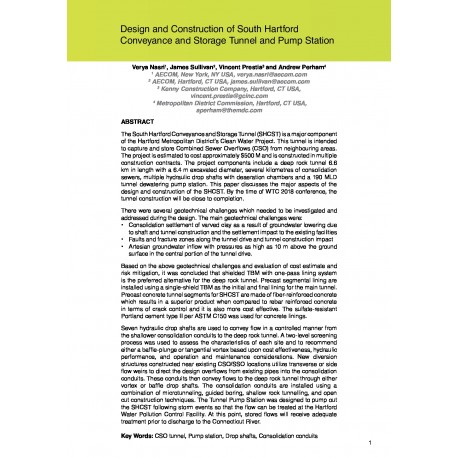Cart
0
0
No document
0,00 €
Total
Document successfully added to your shopping cart
Quantity
Total
There are 0 items in your cart.
There is 1 item in your cart.
Total documents
Total shipping
To be determined
Total
Search & filter
Search for a publication
Search & filter

Design and Construction of South Hartford Conveyance and Storage Tunnel and Pump Station
165_design_and_construction_of_s
V. Nasri / J. Sullivan / V. Prestia / A. Perham
The South Hartford Conveyance and Storage Tunnel (SHCST) is a major component of the Hartford Metropolitan District’s Clean Water Project. This tunnel is intended to capture and store Combined Sewer Overflows (CSO) from neighbouring areas. The project is estimated to cost approximately $500 M and is constructed in multiple construction contracts. The project components include a deep rock tunnel 6.6 km in length with a 6.4 m excavated diameter, several kilometres of consolidation sewers, multiple hydraulic drop shafts with deaeration chambers and a 190 MLD tunnel dewatering pump station. This paper discusses the major aspects of the design and construction of the SHCST. By the time of WTC 2018 conference, the tunnel construction will be close to completion.There were several geotechnical challenges which needed to be investigated and addressed during the design. The main geotechnical challenges were:• Consolidation settlement of varved clay as a result of groundwater lowering due to shaft and tunnel construction and the settlement impact to the existing facilities• Faults and fracture zones along the tunnel drive and tunnel construction impact• Artesian groundwater inflow with pressures as high as 10 m above the ground surface in the central portion of the tunnel drive.Based on the above geotechnical challenges and evaluation of cost estimate and risk mitigation, it was concluded that shielded TBM with one-pass lining system is the preferred alternative for the deep rock tunnel. Precast segmental lining are installed using a single-shield TBM as the initial and final lining for the main tunnel. Precast concrete tunnel segments for SHCST are made of fiber-reinforced concrete which results in a superior product when compared to rebar reinforced concrete in terms of crack control and it is also more cost effective. The sulfate-resistant Portland cement type II per ASTM C150 was used for concrete linings.Seven hydraulic drop shafts are used to convey flow in a controlled manner from the shallower consolidation conduits to the deep rock tunnel. A two-level screening process was used to assess the characteristics of each site and to recommend either a baffle-plunge or tangential vortex based upon cost effectiveness, hydraulic performance, and operation and maintenance considerations. New diversion structures constructed near existing CSO/SSO locations utilize transverse or side flow weirs to direct the design overflows from existing pipes into the consolidation conduits. These conduits then convey flows to the deep rock tunnel through either vortex or baffle drop shafts. The consolidation conduits are installed using a combination of microtunneling, guided boring, shallow rock tunnelling, and open cut construction techniques. The Tunnel Pump Station was designed to pump out the SHCST following storm events so that the flow can be treated at the Hartford Water Pollution Control Facility.


